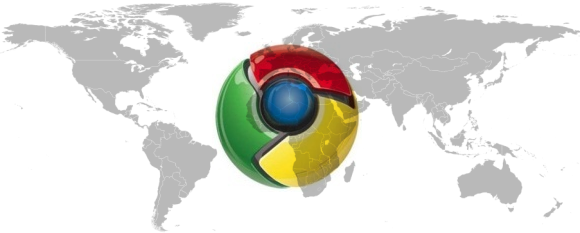
Google made a huge splash when it announced its plans for the Chrome operating system, a web-centric OS where essentially everything is run through a web browser. One great promise of Google’s Chrome OS is the arrival of low-cost, lightweight hardware, since most of the storage and other data handling is done in the cloud. Perhaps that 100-dollar computer will finally become a reality.
But there is a problem. A rather big one. The strength of the Chrome OS, that it makes maximum use of online resources, also limits its potential adoption. To have any real use of the OS you need a decent Internet connection, and that has some significant implications we need to look at.
5 billion without Internet access
Before we even discuss broadband, let us first get one piece of statistic out in the open: 74% of the world population doesn’t have Internet access. At all.
In other words, 5 billion of the world’s 6.8 billion people will have little use for Google’s Chrome OS because they don’t have Internet access.
This is the current Internet penetration shown by region:
- Africa: 6.8%
- Asia: 19.4%
- Europe: 52%
- North America: 74.2%
- South America and Caribbean: 30.5%
- Australia and Oceania: 60.4%
- Middle East: 28.3%
Google’s Chrome OS is a great idea. Put as much as possible into the cloud, and keep the physical device as a “thin client” to access this functionality. However, this great depence on Internet connectivity has left the OS virtually useless for the vast majority of the world population, especially those who would have benefited the most from a low-cost, lightweight computer.
Now that a $100 computer is actually starting to look plausible, it’s ironic that those in true need of one won’t be able to use it. It will remain a luxury item, a secondary computer to those better off.
An even bleaker outlook: broadband
The numbers so far have been about Internet access, any kind, but to properly use a Web OS like the Chrome OS, you really need a broadband connection. This disqualifies an even larger percentage of the population. The mere thought of downloading and uploading documents and other data over an old dial-up connection makes us shiver.
So how common is broadband? Not as common as you might expect. For example, in the United States, 74.1% of the population has Internet access, but as of 2008, only 57% were accessing the Internet over a broadband connection. You could say that this makes Chrome OS unusable to 43% of the US population.
| Country | Internet penetration (total) | Broadband Internet penetration |
|---|---|---|
| United States | 74.1% | 57% |
| Canada | 74.9% | 65% |
| United Kingdom | 76.4% | 55% |
| Australia | 80.1% | 59% |
| France | 69.3% | 54% |
| Spain | 71.8% | 49% |
| Germany | 65.9% | 47% |
| Sweden | 89.2% | 54% |
| Japan | 75.5% | 55% |
These countries are just a few examples to give you an idea of what the broadband penetration tends to look like. More examples can be found on ITIF’s homepage.
And remember that “broadband” isn’t always very good either. It’s usually defined as 256 kbps and up, and that lower spectrum of the broadband definition is hardly a performance monster. Downloading just one megabyte over a 256 kpbs connection takes more than 30 seconds even under ideal circumstances. Many web pages are larger than that.
So even among those who by definition have broadband Internet access, many will have far from an ideal experience of Chrome OS.
Final thoughts (and a happy ending?)
Don’t get us wrong, we at Pingdom like the concept behind Google’s Chrome OS. It’s just that we haven’t seen anyone mention this whole dilemma, so we wanted to shine some light on the actual implications of an OS that is virtually useless without Internet access.
That said, we’d like to end on an optimistic note. The idea behind the Chrome OS does hold a lot of promise. In a sense it’s a throwback to the old days of mainframes and terminals, where computing resources and storage are centralized and accessible by modest hardware on the user end. As Internet penetration spreads, more and more people will be able to benefit from this often cost-saving model where they don’t have to spend so much on hardware.
Data sources:
Broadband penetration data from ITIF (2008).
Internet penetration data from Internet World Stats (2009).




























